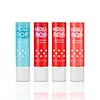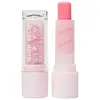What's inside
What's inside
 Key Ingredients
Key Ingredients

 Benefits
Benefits

 Concerns
Concerns

 Ingredients Side-by-side
Ingredients Side-by-side

Diisostearyl Malate
EmollientButyrospermum Parkii Butter
Skin ConditioningPolyglyceryl-2 Triisostearate
EmulsifyingHelianthus Annuus Seed Oil
EmollientOctyldodecanol
EmollientRicinus Communis Seed Oil
MaskingMicrocrystalline Wax
Emulsion StabilisingCeresin
Emulsion StabilisingMeadowfoam Delta-Lactone
Skin ConditioningEuphorbia Cerifera Wax
Sorbitan Sesquioleate
EmulsifyingOzokerite
Emulsion StabilisingParaffin
PerfumingJojoba Esters
EmollientPolyethylene
AbrasivePrunus Amygdalus Dulcis Oil
Skin ConditioningTrihydroxystearin
Skin ConditioningParfum
MaskingTitanium Dioxide
Cosmetic ColorantDehydroacetic Acid
PreservativeWater
Skin ConditioningTocopherol
AntioxidantPrunus Armeniaca Kernel Oil
MaskingCI 42090
Cosmetic ColorantButylene Glycol
HumectantTheobroma Grandiflorum Seed Butter
Skin ConditioningPyrus Malus Fruit Extract
Skin ConditioningPrunus Persica Fruit Extract
AbrasivePhenoxyethanol
PreservativeEthylhexylglycerin
Skin ConditioningDiisostearyl Malate, Butyrospermum Parkii Butter, Polyglyceryl-2 Triisostearate, Helianthus Annuus Seed Oil, Octyldodecanol, Ricinus Communis Seed Oil, Microcrystalline Wax, Ceresin, Meadowfoam Delta-Lactone, Euphorbia Cerifera Wax, Sorbitan Sesquioleate, Ozokerite, Paraffin, Jojoba Esters, Polyethylene, Prunus Amygdalus Dulcis Oil, Trihydroxystearin, Parfum, Titanium Dioxide, Dehydroacetic Acid, Water, Tocopherol, Prunus Armeniaca Kernel Oil, CI 42090, Butylene Glycol, Theobroma Grandiflorum Seed Butter, Pyrus Malus Fruit Extract, Prunus Persica Fruit Extract, Phenoxyethanol, Ethylhexylglycerin
Polyglyceryl-2 Triisostearate
EmulsifyingPolyethylene
AbrasiveCaprylic/Capric Triglyceride
MaskingDiisostearyl Malate
EmollientPentaerythrityl Tetraisostearate
EmollientPhytosteryl/Isostearyl/Cetyl/Stearyl/Behenyl Dimer Dilinoleate
Skin ConditioningHydrogenated Polyisobutene
EmollientOctyldodecanol
EmollientTridecyl Trimellitate
EmollientTrioctyldodecyl Citrate
EmollientDipentaerythrityl Hexahydroxystearate/Hexastearate/Hexarosinate
Skin ConditioningMacadamia Seed Oil Polyglyceryl-6 Esters Behenate
EmollientSynthetic Wax
AbrasiveSilica Dimethyl Silylate
EmollientCitrullus Lanatus Seed Oil
EmollientCoconut Flower Sugar
AntioxidantIsostearic Acid
CleansingSucrose
HumectantCitrullus Lanatus Fruit Extract
Skin ConditioningHibiscus Sabdariffa Flower Extract
Skin ConditioningTocopherol
AntioxidantStearalkonium Hectorite
Gel FormingEthylene/Propylene Copolymer
AbrasivePropylene Carbonate
SolventEuphorbia Cerifera Wax
Citric Acid
BufferingMaltodextrin
AbsorbentCopernicia Cerifera Wax
Dehydroacetic Acid
PreservativePropylene Glycol
HumectantWater
Skin ConditioningMalic Acid
BufferingAscorbic Acid
AntioxidantTartaric Acid
BufferingCrataegus Monogyna Flower Extract
Skin ConditioningPotassium Sorbate
PreservativeViola Tricolor Extract
EmollientCI 45410
Cosmetic ColorantCI 15850
Cosmetic ColorantCI 19140
Cosmetic ColorantParfum
MaskingSodium Benzoate
MaskingPolyglyceryl-2 Triisostearate, Polyethylene, Caprylic/Capric Triglyceride, Diisostearyl Malate, Pentaerythrityl Tetraisostearate, Phytosteryl/Isostearyl/Cetyl/Stearyl/Behenyl Dimer Dilinoleate, Hydrogenated Polyisobutene, Octyldodecanol, Tridecyl Trimellitate, Trioctyldodecyl Citrate, Dipentaerythrityl Hexahydroxystearate/Hexastearate/Hexarosinate, Macadamia Seed Oil Polyglyceryl-6 Esters Behenate, Synthetic Wax, Silica Dimethyl Silylate, Citrullus Lanatus Seed Oil, Coconut Flower Sugar, Isostearic Acid, Sucrose, Citrullus Lanatus Fruit Extract, Hibiscus Sabdariffa Flower Extract, Tocopherol, Stearalkonium Hectorite, Ethylene/Propylene Copolymer, Propylene Carbonate, Euphorbia Cerifera Wax, Citric Acid, Maltodextrin, Copernicia Cerifera Wax, Dehydroacetic Acid, Propylene Glycol, Water, Malic Acid, Ascorbic Acid, Tartaric Acid, Crataegus Monogyna Flower Extract, Potassium Sorbate, Viola Tricolor Extract, CI 45410, CI 15850, CI 19140, Parfum, Sodium Benzoate
 Reviews
Reviews

Ingredients Explained
These ingredients are found in both products.
Ingredients higher up in an ingredient list are typically present in a larger amount.
Dehydroacetic Acid is fungicide and bactericide. It is used as a preservative in cosmetics. Preservatives help elongate the shelf life of a product.
Dehydroacetic Acid is not soluble in water.
Diisostearyl Malate is an emollient and most often used in lip products. It comes from isostearyl alcohol, a fatty acid, and malic acid, an AHA.
As an emollient, Diisostearyl Malate helps create a thin film on your skin to trap moisture in. This helps keep your skin soft and smooth.
Octyldodecanol is a fatty alcohol. It is primarily used to enhance the texture of products.
As an emulsifier, Octyldodecanol helps prevent the oils and waters from separating. It also prevents ingredients from creating foam when shaken.
Octyldodecanol is created by reducing fatty acid to an alcohol.
Due to its high molecular weight, it does not get absorbed into the skin.
Learn more about OctyldodecanolParfum is a catch-all term for an ingredient or more that is used to give a scent to products.
Also called "fragrance", this ingredient can be a blend of hundreds of chemicals or plant oils. This means every product with "fragrance" or "parfum" in the ingredients list is a different mixture.
For instance, Habanolide is a proprietary trade name for a specific aroma chemical. When used as a fragrance ingredient in cosmetics, most aroma chemicals fall under the broad labeling category of “FRAGRANCE” or “PARFUM” according to EU and US regulations.
The term 'parfum' or 'fragrance' is not regulated in many countries. In many cases, it is up to the brand to define this term.
For instance, many brands choose to label themselves as "fragrance-free" because they are not using synthetic fragrances. However, their products may still contain ingredients such as essential oils that are considered a fragrance by INCI standards.
One example is Calendula flower extract. Calendula is an essential oil that still imparts a scent or 'fragrance'.
Depending on the blend, the ingredients in the mixture can cause allergies and sensitivities on the skin. Some ingredients that are known EU allergens include linalool and citronellol.
Parfum can also be used to mask or cover an unpleasant scent.
The bottom line is: not all fragrances/parfum/ingredients are created equally. If you are worried about fragrances, we recommend taking a closer look at an ingredient. And of course, we always recommend speaking with a professional.
Learn more about ParfumPolyethylene is a synthetic ingredient that helps the skin retain moisture. It is a polymer.
It is also typically used within product formulations to help bind solid ingredients together and thicken oil-based ingredients. When added to balms and emulsions, it helps increase the melting point temperature.
This ingredient is a form of glycerin with emulsifying and emollient properties.
As an emulsifier, this ingredient helps keep products together while adding a thick texture. The manufacturer states this ingredient has emollient properties. Emollients help keep the skin hydrated by trapping moisture in.
Polyglyceryl-2 Triisostearate is created by reacting diglycerin and isostearic acid. Due to the isostearic acid base, it may not be safe for Malassezia or fungal acne.
Learn more about Polyglyceryl-2 TriisostearateTocopherol (also known as Vitamin E) is a common antioxidant used to help protect the skin from free-radicals and strengthen the skin barrier. It's also fat soluble - this means our skin is great at absorbing it.
Vitamin E also helps keep your natural skin lipids healthy. Your lipid skin barrier naturally consists of lipids, ceramides, and fatty acids. Vitamin E offers extra protection for your skin’s lipid barrier, keeping your skin healthy and nourished.
Another benefit is a bit of UV protection. Vitamin E helps reduce the damage caused by UVB rays. (It should not replace your sunscreen). Combining it with Vitamin C can decrease sunburned cells and hyperpigmentation after UV exposure.
You might have noticed Vitamin E + C often paired together. This is because it is great at stabilizing Vitamin C. Using the two together helps increase the effectiveness of both ingredients.
There are often claims that Vitamin E can reduce/prevent scarring, but these claims haven't been confirmed by scientific research.
Learn more about TocopherolWater. It's the most common cosmetic ingredient of all. You'll usually see it at the top of ingredient lists, meaning that it makes up the largest part of the product.
So why is it so popular? Water most often acts as a solvent - this means that it helps dissolve other ingredients into the formulation.
You'll also recognize water as that liquid we all need to stay alive. If you see this, drink a glass of water. Stay hydrated!
Learn more about WaterEuphorbia Cerifera wax comes from a shrub in Northern Mexico. It is used to stabilize formulations and has emollient properties.
Emollients form a thin layer on top of skin to prevent water from evaporating, keeping skin and lips hydrated.
According to a manufacturer, this wax can range from a yellow/brown color to translucent.
Learn more about Euphorbia Cerifera Wax